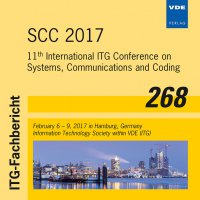Spatially Coupled Hybrid Concatenated Codes
Konferenz: SCC 2017 - 11th International ITG Conference on Systems, Communications and Coding
06.02.2017 - 09.02.2017 in Hamburg, Germany
Tagungsband: SCC 2017
Seiten: 6Sprache: EnglischTyp: PDF
Persönliche VDE-Mitglieder erhalten auf diesen Artikel 10% Rabatt
Autoren:
Moloudi, Saeedeh; Lentmaier, Michael (Department of Electrical and Information Technology, Lund University, Lund, Sweden)
Graell i Amat, Alexandre (Department of Signals and Systems, Chalmers University of Technology, Gothenburg, Sweden)
Inhalt:
The main purpose of this paper is to make the study of spatially coupled turbo-like codes (SC-TCs) more complete by investigating the impact of spatial coupling on the thresholds of hybrid concatenated codes (HCCs). In our previous studies, we introduced some classes of SC-TCs and considered their density evolution (DE) analysis. The obtained results indicated that for a fixed coupling memory, braided convolutional codes (BCCs) have the best belief propagation (BP) thresholds among the considered classes. Besides having excellent BP thresholds, BCCs have good distance properties and their minimum distance grows linearly with block length. Similarities between BCCs and HCCs make HCCs good competitors for BCCs. This has motivated us to investigate the impact of spatial coupling on HCCs. In this paper, we introduce two spatially coupled ensembles of HCCs, referred to as Type-I SC-HCCs and Type-II SC-HCCs. Then, we derive the exact density evolution (DE) equations for the uncoupled and the coupled ensembles for the binary erasure channel (BEC). Finally, considering different component encoders, we compute the thresholds of the SC-HCC ensembles and compare them with the thresholds of BCCs for a range of different rates.


